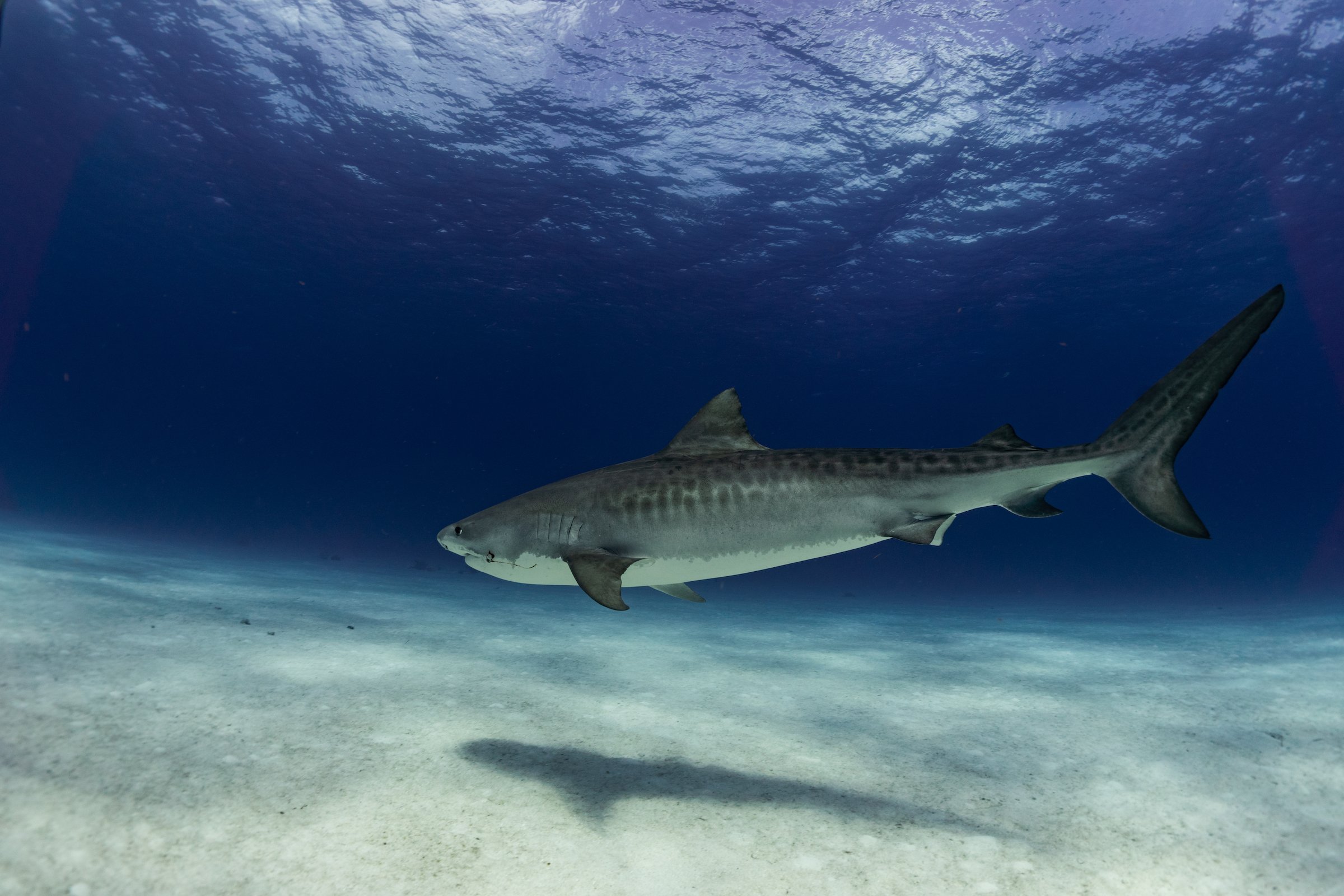Valuation Report: Bahamas Tiger Sharks
Tiger Sharks Alive: A value of $33.1 million
The tiger shark (Galeocerdo cuvier) is one of the large iconic shark species. Despite this status, tiger sharks are also prone to being hunted. They have gained some notoriety through events such as Discovery Channel’s Shark Week, and shark divers have become accustomed to uncaged diving with tiger sharks at Tiger Beach. Due to its proximity to the Gulf Stream, the Bahamas region receives warm, nutrient-rich waters that support marine life and mangrove nurseries. Since the Bahamas declared its entire Exclusive Economic Zone a shark sanctuary in 2011, the tiger shark population has remained stable. Although tiger sharks are present across various parts of the Bahamas such as in Bimini and Eleuthera Islands, there has been an unusually high aggregation of large female tiger sharks at Tiger Beach, a one square mile shallow, warm sand flat located roughly 30km west of West End, in the Grand Bahama.
Based on a field study conducted at Tiger Beach by Sulikowski et al. (2016), it was found that due to year-round calm and warm waters, Tiger Beach serves as a gestation ground for gravid female tiger sharks; a refuge for immature females from male mating harassment; and, most importantly a protected area from fisheries bycatch.
From the ecological perspective, as an apex predator with high mobility, tiger sharks play a crucial role in connecting habitats, transporting nutrients, controlling prey populations, and maintaining the balance of the marine ecosystem. The tiger sharks also keep the marine ecosystem healthy by preying on sick, weak, and dying individuals and their presence influences prey behavior. For instance, with the green sea turtles tiger sharks keep their population under control and prevent them from overgrazing seagrass beds that are essential for marine life in general, and commercial fish species in particular. This, in turn, has a positive indirect implication on marine biodiversity and on the commercial fishing industry.
One of the important elements in valuing the ecosystem services sharks provide is to look at the key local food web interactions for the tiger shark in the waters around the Bahamas with other species that share the waters with the tiger shark population. It includes predators and prey. The relationship matrix is vital to understanding the importance of the tiger shark relative to the other species.
One complexity when it comes to the valuation of the sharks in the Bahamas is the limited available survey data. In order to overcome this challenge, the shark population trends are inferred using the relative abundance trend data in Bimini, as published in Smukall et al. (2022). Smukall in the Save Our Seas Foundation’s 2019 annual report indicated a minimum possible population size of 51 individuals. It represents the number of individual tiger sharks marked and tracked by the Bimini Biological Field Station Foundation using satellite and acoustic trackers. However, based on personal communications with regional experts the population size is likely to be closer to 1,000-1,500 individuals for the entire Bahamas region. It is likely that these individuals would include all ages and are not only “high-earning” adults. Based on those conversations it would seem that perhaps the minimum population size is 150 individuals. These would refer to the individuals that are more commonly encountered in touristic locations. As a result, the baseline scenario is based on these 150 tiger sharks.
The biggest data gap we struggled with is the Carbon value that one should attribute to sharks. While it is understood that sharks contribute to solving the planet’s carbon threat **, there is a lack of scientific evidence that can justify their actual impact in terms of carbon value. Future studies and reports will close this gap, at which time the value of sharks will increase greatly. We will update these reports as new data becomes available.
The baseline value of the tiger shark population in the Bahamas waters is $33.1 million. This value is comprised of the following:
+ Aesthetic Value: $1.5 million
+ Economic Value: $29.6 million
+ Hedge Value: $0.5 million million
= Species Existence value: $31.5 million
+ Impact Value: $1.5 million
= Total Conservation Value: $33.1 million
Averaging the total value over the minimum population size of 150 individuals, the value per individual shark is $220,335.
While all of the numbers above are great arguments why we should protect our sharks as an investment, ultimately, the most important reason why sharks matter is the important role they play in keeping our ocean healthy. And that should be the overriding reason why we respect and protect sharks.
A quick overview of the components of the report:
To request the full report, please contact us via email.
SPECIAL THANKS
Endangered Wildlife OÜ and Shark Allies would like to thank Dr. Tristan Guttridge for his expert advice in preparing this report and Bracenet GmbH and Daniel Roesner for their financial support.



